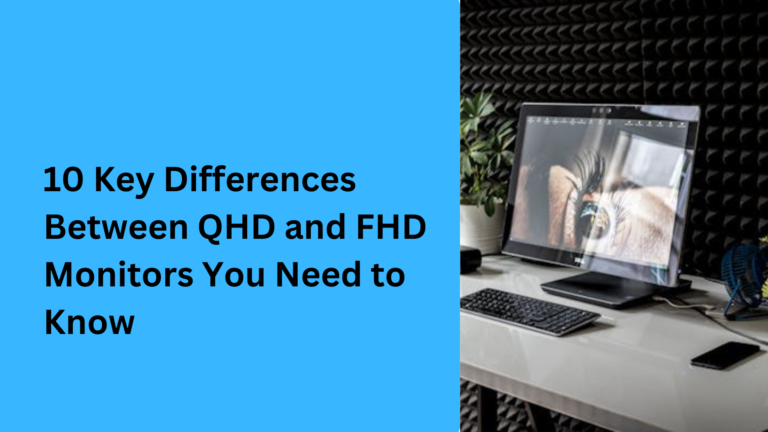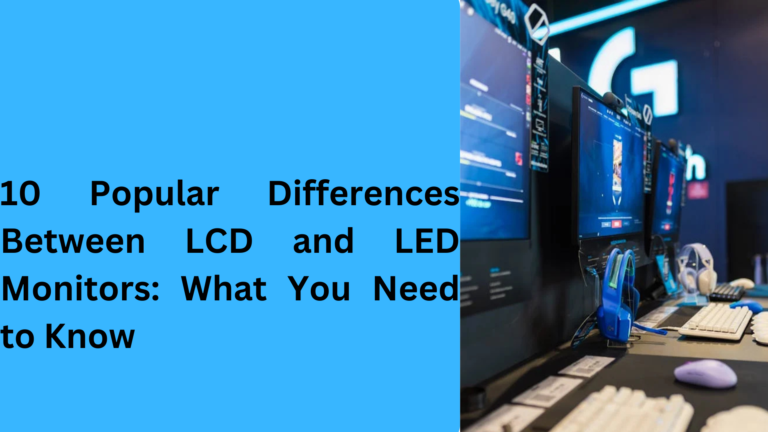10 Popular Differences Between Dell and Samsung Monitors You Should Know
When it comes to choosing the right monitor for your needs, the decision between a Dell and Samsung monitor can be overwhelming. Both brands offer high-quality options, but each has unique features that can influence your decision. This guide explores the five key differences between Dell and Samsung monitors, helping you make an informed choice based on your preferences. Let’s dive into these differences and see which monitor brand suits your needs best.
1. Display Quality: Dell vs Samsung Monitor Screen Performance
When comparing the display quality of Dell and Samsung monitors, it’s essential to look at several factors such as resolution, brightness, and color accuracy. Dell monitors typically excel in offering highly accurate color reproduction, making them a popular choice for professional tasks like photo editing and graphic design. On the other hand, Samsung monitors often feature vibrant colors and deeper contrasts, which are ideal for gaming and multimedia use.
Dell’s IPS technology offers superior viewing angles and consistent color across different lighting conditions. Samsung, however, is known for its Quantum Dot technology in many of its higher-end monitors, offering brighter screens and better HDR (High Dynamic Range) support for an immersive experience.
If you’re considering buying a monitor for design work or professional tasks, a Dell monitor might be a better choice due to its color consistency. But for gaming and entertainment, Samsung’s brighter screens and high contrast ratios could provide a more satisfying experience.
2. Design and Build Quality: Dell vs Samsung Monitor Aesthetics and Durability
When it comes to design, Dell monitors are known for their sleek, professional appearance, often featuring slim bezels and sturdy builds. Many users appreciate the simple, minimalist style that fits seamlessly in office environments. Dell monitors are also durable, with solid stands and reliable construction designed for long-term use.
Samsung monitors often focus on a more futuristic design, with ultra-thin bezels and stylish stands. Their curved models, such as the Samsung Odyssey series, are designed to provide an immersive experience, especially for gaming. The build quality of Samsung monitors is generally high, but some users report that their stands can feel a little less stable compared to Dell’s.
If you prioritize a sleek, professional design for a home office setup, Dell might be the better option. But if you’re looking for something more stylish or immersive, particularly for gaming or entertainment, Samsung’s modern designs may appeal to you.
3. Price Range: Dell vs Samsung Monitor Cost-Effectiveness
Price is a significant factor when deciding between Dell and Samsung monitors. In general, Dell monitors are slightly more expensive than Samsung monitors in comparable categories. This price difference is often due to Dell’s focus on premium build quality, color accuracy, and advanced professional features.
Samsung, however, offers more affordable options in a variety of models, from entry-level monitors to mid-range options. While Samsung’s budget monitors may lack the high-end features of Dell’s professional lineup, they still offer excellent value for money, especially for those who want a monitor for gaming or casual use.
If you’re looking for a high-performance monitor without breaking the bank, Samsung could offer more budget-friendly options. But if you’re willing to invest a bit more for professional-level performance and advanced features, Dell might be the better investment.
4. Connectivity and Ports: Dell vs Samsung Monitor Compatibility Options
When comparing the connectivity options of Dell and Samsung monitors, both brands offer a wide range of ports, but there are some key differences to consider. Dell monitors generally come with a variety of inputs, including HDMI, DisplayPort, USB-C, and sometimes VGA, which makes them compatible with a wide array of devices. Dell’s monitors also often feature multiple USB hubs for easy access to peripherals, which is convenient for office setups.
Samsung monitors, particularly the higher-end models, also offer HDMI, DisplayPort, and even USB-C in some cases. However, Samsung has been particularly praised for its gaming monitors, many of which come with FreeSync and G-Sync compatibility for smoother gameplay. If you’re a gamer or have multiple devices to connect, Samsung might be the better option due to its support for advanced gaming technologies.
For those who need easy device connectivity, Dell monitors are great for professional environments and office setups. For gamers or users who need advanced display features, Samsung offers better value with gaming-specific ports and sync technologies.
5. Customer Support and Warranty: Dell vs Samsung Monitor After-Sales Service
Customer support and warranty services are crucial when choosing between Dell and Samsung monitors. Dell is well-known for its exceptional customer support and extended warranties, often offering up to 3 years of coverage on many of their models. Dell’s support team is highly rated, and their monitors typically come with comprehensive return policies and repair services.
Samsung also offers reliable customer support, but their warranty services can vary by region and product model. Some users report that Samsung’s after-sales support isn’t as extensive or responsive as Dell’s, especially when it comes to handling defective units or repairs.
If customer service and warranty are your top concerns, Dell may provide more peace of mind with its longer warranty periods and faster response times. However, Samsung still offers solid customer support and is a good choice for those who are looking for less frequent interactions with support services.
6. Panel Technology: Dell vs Samsung Monitor Display Types
The type of panel technology used in monitors is a major factor that influences performance and user experience. Dell primarily focuses on IPS (In-Plane Switching) panels, which are known for their excellent color accuracy, wide viewing angles, and consistent performance under various lighting conditions. These are ideal for professionals who need precision in tasks like photo editing, video editing, and CAD design.
Samsung, on the other hand, offers a wider variety of panel types, including VA (Vertical Alignment) and IPS, with some models featuring Quantum Dot technology for enhanced brightness and richer colors. Samsung’s VA panels are particularly popular among gamers because they offer deeper blacks, higher contrast ratios, and excellent performance in dimly lit environments.
For professional work requiring accurate colors, Dell’s IPS panels are a go-to option. For gaming enthusiasts or those who prioritize deeper contrast and immersive visuals, Samsung’s VA or Quantum Dot displays are worth considering.
7. Gaming Performance: Dell vs Samsung Monitors for Gamers
When comparing gaming performance, Samsung often takes the lead due to its focus on creating monitors tailored for gaming enthusiasts. Samsung’s Odyssey series is especially popular for its high refresh rates (up to 240Hz), low response times, and curved designs that provide a more immersive gaming experience. Many of Samsung’s gaming monitors also support NVIDIA G-Sync and AMD FreeSync, minimizing screen tearing and input lag.
Dell monitors, while not as gaming-focused as Samsung’s, still provide reliable options for casual and professional gaming. Dell’s Alienware lineup, for instance, is specifically designed for gamers and includes features like high refresh rates, adaptive sync technology, and excellent build quality.
If gaming is your priority, Samsung’s gaming-focused features and immersive designs make it the better choice. However, Dell’s Alienware monitors are a strong competitor for gamers seeking premium quality.
8. Energy Efficiency: Dell vs Samsung Monitor Power Consumption
Energy efficiency is an increasingly important factor for consumers, particularly for those who use their monitors for long hours. Dell monitors are known for being energy-efficient, with many models earning Energy Star certifications and featuring eco-friendly settings that reduce power consumption without sacrificing performance. Dell’s power-saving features, such as automatic brightness adjustment, are particularly useful for office environments.
Samsung monitors also offer energy-saving features, including Eco-Saving Plus mode, which adjusts screen brightness to reduce power consumption. However, some of Samsung’s high-end gaming monitors with advanced technologies, like high refresh rates and Quantum Dot displays, can consume more power compared to Dell’s energy-efficient options.
If you’re concerned about power usage and want a monitor that aligns with environmentally conscious values, Dell is a slightly better option. For users who prioritize performance over energy efficiency, Samsung’s gaming and multimedia models are worth the extra power draw.
9. Ergonomics and Adjustability: Dell vs Samsung Monitor Comfort Features
The ability to adjust your monitor for maximum comfort is crucial, especially for users who spend long hours in front of the screen. Dell monitors are widely regarded for their excellent ergonomic designs, including height adjustment, swivel, tilt, and pivot functions. This makes them highly versatile for both professional workstations and home offices.
Samsung monitors also offer ergonomic features, but these tend to be less advanced in many models, especially in the budget range. Higher-end Samsung monitors, like the Odyssey series, do include adjustable stands and wall-mount options, but the flexibility may not match Dell’s professional monitors.
For users prioritizing ergonomics and a comfortable setup, Dell monitors are more likely to meet those needs. However, Samsung’s curved monitors can provide natural viewing comfort, especially for entertainment purposes.
10. Durability and Longevity: Dell vs Samsung Monitor Lifespan
Durability and longevity are important considerations when investing in a monitor. Dell monitors are built with high-quality materials, ensuring long-term reliability. Many users report using Dell monitors for years without noticeable performance degradation, even with heavy daily use.
Samsung monitors, while durable, often focus more on advanced features and stylish designs, which can sometimes result in slightly less robust construction compared to Dell. However, Samsung’s high-end monitors, like those in the Odyssey and Smart Monitor series, are built to last and offer cutting-edge technologies designed for longevity.
If you’re looking for a monitor that will last for years, Dell’s reputation for durability makes it a safer bet. For users who want advanced features and cutting-edge technology, Samsung’s monitors are built to deliver high performance, even if they may not be as rugged as Dell’s models.
FAQs About Dell vs Samsung Monitors
1. Which is better for professional use: Dell or Samsung monitors?
Dell monitors are often considered better for professional use due to their color accuracy, IPS panels, and ergonomic designs. They are ideal for photo editing, graphic design, video editing, and CAD work, where precise color reproduction and long-term comfort are essential. Samsung monitors, while capable, focus more on vivid displays and gaming-friendly features, which may not be as critical for professional workflows.
2. Are Samsung monitors good for gaming compared to Dell monitors?
Yes, Samsung monitors are excellent for gaming, especially models like the Samsung Odyssey series, which feature high refresh rates (up to 240Hz), low response times, and FreeSync/G-Sync compatibility for smoother gameplay. While Dell offers gaming monitors, such as the Alienware lineup, Samsung’s curved displays and Quantum Dot technology provide a more immersive gaming experience, making it a preferred choice for hardcore gamers.
3. What are the key differences in build quality between Dell and Samsung monitors?
Dell monitors are known for their sturdy build quality, featuring durable materials and solid stands that offer great adjustability. They are designed for office setups and long-term use, making them a reliable choice for professionals. Samsung monitors, while stylish and innovative in design, sometimes have stands that feel less stable in budget models. However, Samsung’s high-end monitors, like the Smart Monitor and Odyssey series, are built with premium materials for better durability.
4. Which brand offers better energy-efficient monitors: Dell or Samsung?
Dell monitors generally outperform Samsung in terms of energy efficiency, with many models featuring Energy Star certifications and eco-friendly settings like power-saving modes and automatic brightness adjustment. Samsung monitors also offer Eco-Saving Plus features, but their gaming and multimedia-focused models often consume more power due to high refresh rates and Quantum Dot technology.
5. Are Dell or Samsung monitors better for multitasking and productivity?
Dell monitors are often better for multitasking and productivity because of their wide range of connectivity options, including USB-C, HDMI, DisplayPort, and multiple USB hubs. Many Dell models also feature ergonomic adjustments and split-screen capabilities. Samsung monitors, particularly those with ultrawide screens or Smart Monitor features, are also good for multitasking, but they’re more suited to casual users or those integrating entertainment into their work setup.


